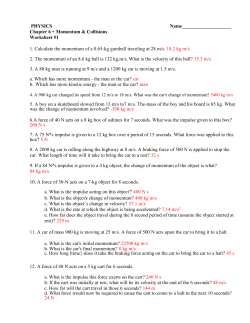
Solutions to Practice Exam 2 1. Initially we have a system (machine
Solutions to Practice Exam 2 1. Initially we have a system (machine-‐gun + cart) at rest. The initial linear momentum is =0. When we fire a bullet in one direction, the cart starts moving in the opposite direction because of the conservation of linear momentum. Each bullet increases the linear momentum of the cart by an amount -‐mbvb: if we fire N bullets, the cart linear momentum will be: -‐Nmbvb: pi=0. pf=mcvc+ Nmbvb pf= pi à mcvc=-‐Nmbvb I want to calculate N: I solve the above equation. N=-‐ mcvc/(mbvb)=-‐(6.25 * 104kg* 0.5 m/s)/(0.025Kg*(-250m/s)) (the bullets are fired off the back: they have negative velocity). We get N=5000. Answer: D. 2. The change in momentum is equal to the final momentum minus the initial momentum: Δp= pf-‐pi=m(vf-‐ vi) We have to remember that the momentum is a vector: the initial and final velocities have opposite signs. We get: Δp=0.2kg*(60m/s-(-40m/s))=0.2kg*100m/s=20 kg*m/s Answer: D. 3. This is an example of inelastic collision in two dimensions: the duck flies horizontally, the bullet vertically. After the collision, the system (duck+bullet) will fly in a direction which has both horizontal and vertical components. The momentum needs to be conserved component by component. pi,x=mdvd pf,x=md+bvd+b,x pi,y=mbvb pf,y=md+bvd+b,y pf= pi à pf,x= pi,x; pf,y= pi,y md+bvd+b,x= mdvd à vd+b,x= mdvd/ md+b=(1.00kg*1.50m/s)/1.01kg=1.485m/s md+bvd+b,y= mbvb à vd+b,y= mbvb/ md+b=(0.010kg*100m/s)/1.01kg=0.99 m/s The speed can then be found as: vd+b2=(vd+b,x2+ vd+b,y2) à vd+b=1.78m/s Answer: D. 4. The crate weighs mg=50N. To calculate the change in potential energy, we need to calculate the height of the ramp. The ramp is 25.0 m long and it is inclined 10o with the horizontal. The height is: h=25.0m*Sin(10o)=4.34m. The gain in potential energy is ΔU=Uf-Ui=mgh=220 J. Answer: D. 5. The two balls initially fly in opposite directions. Their momenta are: p1=m1v1 p2=m2v2 pi=p1+p2=0.4kg*(-15m/s)+0.6kg*(15m/s)=3.0 kg*m/s. The momentum is conserved in the inelastic collision: pf = pi à (m1+m2)vf=3.0 kg*m/s à Answer: B. 6. The free body diagram of the problem is as follows: vf=(3.0 kg*m/s)/(1.0kg)=3.0 m/s We write Newton’s law in the horizontal and vertical directions: ΣFy=may à N-‐mg=0 à N=mg. ΣFx=max à μsN=mv2/r à v2= μsmgr/m= μsgr à v=15.8 m/s Answer: C. 7. The situation is the following: When the pendulum is released, it has a potential energy given by mgH. At the bottom of the swing, the potential energy is converted into kinetic energy (the mechanical energy is conserved). We have to calculate H. H=L-Lcosθ=0.18m. For the conservation of the mechanical energy we have: Ui=Kf à v=1.88 m/s. Answer: D. à mgH=1/2mv2 à v2=2gH
© Copyright 2025













